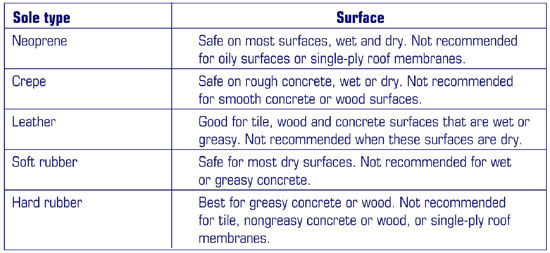Editor's note: This is part two of a two-part series about slip hazards. Part one, "Slip sliding away," was in the November issue.
Although there are many reasons for slips—wet surfaces, spills, weather hazards, etc.—there also are many ways to prevent slips and keep your feet firmly on the ground.
As mentioned in November's column, friction is a physics principle that contributes to falls. Friction is measured by the coefficient of friction—the ratio of an object's weight to the frictional force required to move it.
Federal regulations specified in the Americans with Disabilities Act recommend a coefficient of friction of 0.6 or higher for walking surfaces. A usual measurement for rubber on dry asphalt is between 0.6 and 0.7 (measured between car tires and roadways).
Coefficients of friction depend on surface conditions, and measurements can change dramatically as conditions change. Most people have firsthand experience with changes in coefficients of friction while driving during winter. The 0.7 measurement for rubber on asphalt can fall as low as 0.2 for the slipperiest types of ice. And wet surfaces have lower coefficients than dry surfaces.

Suitable shoes and boot soles for walking surfaces
Although rubber boot soles and asphalt shingles are different from car tires and roadways, the coefficients of friction principle applies to all surfaces. When it is raining or snowing or there is dew or ice on a roof's surface, the coefficient of friction is lower than in dry conditions and employees are more likely to slip.
Workers can prevent accidents by wearing the right kind of shoes for different jobs. The figure outlines suitable shoe and boot soles for various walking surfaces.
Other ways to prevent slips include keeping work sites clean and well-lit. Debris on a roof can cause a worker to slip if the debris is slippery or covering water or ice. If a worker missteps on debris, he can lose his center of gravity and slip because he is off-balance.
Working at night also may mask slipping hazards where lighting is not adequate. Cooler nighttime temperatures may not allow water to evaporate or ice to melt, meaning these hazards may remain on a roof unless manually removed. When working on a darkened roof area, workers must know about all ice, frost or ponded water.
And workers need to make full repairs and avoid quick fixes so all roof surfaces are as dry and stable as possible. Inadequate repairs can result in roof surface areas where water or ice gathers. These repairs also may be inadequately secured causing a worker to trip or slip on the material.
All people on-site need to be mindful of where they walk and consider walking surface conditions, especially when conditions may cause surfaces to become more slippery.
To keep workers upright and safe while walking on slippery surfaces, remind them to do the following:
- Take small steps. Taking steps that are shorter than their foot lengths will help workers keep their balance.
- Walk with toes pointed slightly outward.
- Keep hands free of objects when possible. To test how carrying objects affects balance, in a safe area, have workers walk on a slippery surface with their hands in their pockets and then out of their pockets. They should note the differences in balance.
- Wear the most suitable shoes for each job.
Slips are common occurrences that people often find funny, but roofing workers always should be looking for ways to eliminate slips. What may be a harmless slip on the ground could be a serious injury or death on a roof.
Amy Staska is NRCA's director of education programs.

